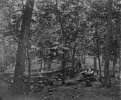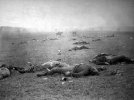I've got a full library shelf of Civil War history in my home.
Notable battles that included some form of ad hoc constructed defense systems included Antietam (1862), Fredericksburg (1862), Chancellorsville (1863), and Gettysburg (1863).
The first major engineered defensive position was at the Siege of Vicksburg (1863) on the Mississippi occurring at the same time as the Battle of Gettysburg in the East. Battles prior to Vicksburg in the West were largely meeting engagements between the armies, or sieges at already constructed fortifications along the river communication lines in the west. Following Vicksburg, the Confederate forces went largely over to the defense to protect against further splitting of the Confederate territory, the most notable battle being Sherman's March to the Sea (1864) eventually leading to a practical merger of all Confederate forces at Petersburg's massive siege defense..
That's why I wrote the "majority" of engagements and I was too lazy to list all the known instances where fortifications were used, so I put Petersburg as example for heavy fortifications on one end of the imaginary fortification scale and Antietam as example for the clever use of terrain features on the other end. You might have noticed the word "included" up there.
I didn't deny the fact that field fortifications were built, anywhere, though.
My very rough outline was supposed to demonstrate that the game has a fixed time frame in which each and every unit will reach the dug in state, if it isn't routed or forced to retreat, so that each and every stationary custom CW unit would start to build fortifications, which would be ahistoric.
The dug-in state also grants a level of protection (bonus modifiers) in the game, historical makeshift defenses may not have offered.
I also mentioned the precursor role of the Petersburg fortifications. The example of Petersburg still disturbed the German military in the 1900s to such extent, that they developed a rather daring (some say dreamful) plan of attack that intended a fast move into France - ignoring the neutrality of the Low Countries - in case Germany would be at war with France, to avoid the particular trench line/siege warfare seen in the CW, btw.
The Gettysburg engagements at Culp's Hill involved makeshift breastworks on the hill's crest only, most other units didn't have/create breastworks. They mainly consisted of collected stones interspersed with some felled trees. The Union troops had occupied the hill for 15-17 hrs before Greene ordered to build those works. Greene was a civil engineer before the war, so he understood the benefits of such measure, but he had to convince his commanders that such breastworks would be useful and insist on the construction. When the site got stormed, Green then rotated units behind the breastworks after each salvo, which created a scary salvo RoF and an evil rain of bullets.
But the creation of such makeshift positions was
definitely anything but a standard procedure (in the Union Army) at the time.
Without the breastwork the Union unit on the crest would have been overrun.
The flanks were not secured like that, Greene had to stretch his troops on the flank to cover the lower part of that sector, so he could only field a single-line defense - which had no cover at all, maybe except for some trees.
The crest:

Other sectors in the Gettysburg battle area looked like this:

Or like this (Little Round Top):

So, except for the "fortified" crest, both sides' units had to rely on terrain features, and Conf. units often had to cross open ground, if they wanted to reach Union lines.
During the Battle of Antietam, a 700-meters section of the "sunken road" was used as defensive position by Conf. troops:

Conf. forward sharpshooters were placed well behind this bridge, using rocks, stone walls and trees as cover, the bridge and its approach was covered by Conf. artillery, but Union troops managed to cross the bridge with disproportional heavy losses, eventually. No fortifications involved:

In order to reach/destroy this artillery position ....

.... the main attack of the Union troops picked this Conf. flank (Hagerstown Turnpike), which was another terrain feature, not a constructed defensive line:

The Union captured the Conf. batteries, actually.
The terrain between the Union units and the Conf. troops consisted of meadow land with a corn field in the center and several woods on at least one end, the edges were used by some Conf troops as cover. No fortifications on the flanks, rather mobile warfare that included a cavalry vs. cavalry engagement and Conf. inf elements using terrain features as cover, where then the Conf. managed to lure the Union troops into a trap where they could fire at the Union's follow-up division from 3 sides, eventually. If the Confederate center line had some makeshift fortification, then it didn't play a major role, as the battle centered around the supposed weak flank of the Conf.
Following Gettysburg in the East, the Confederate Forces went largely over to the defense, either maneuvering into blocking positions and building hasty engineered defenses to keep Union Forces from attacking Richmond, or, at Petersburg (1864-5), constructing a massive complex of fortifications which were a precursor to World War I defense systems.
And if one summarizes all the CW battles that featured meeting engagements, flexible offensive or defensive frontline manoeuvres or agile counterattacks, then one should come to the conclusion, that the majority of battles did not feature sieges, attacks on fortified blocking positions or even complex fortifications. But I did not deny that the Conf. were forced to shift their strategy during later stages of the war, either.











